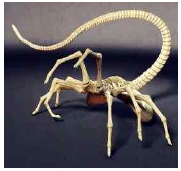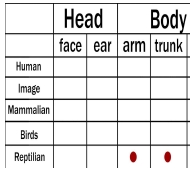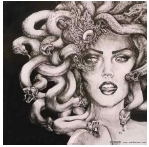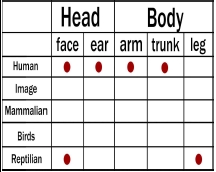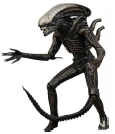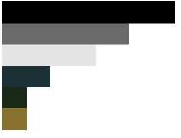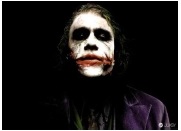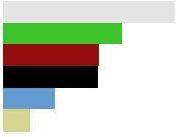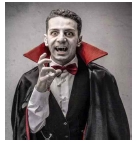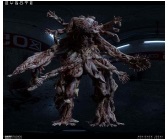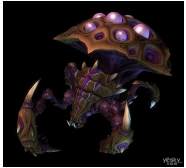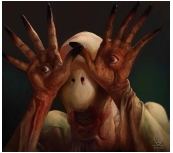
Study on the design of game Horror character : Focused on the graft design Method of creatures
Copyright ⓒ 2019 The Digital Contents Society
This is an Open Access article distributed under the terms of the Creative Commons Attribution Non-CommercialLicense(http://creativecommons.org/licenses/by-nc/3.0/) which permits unrestricted non-commercial use, distribution, and reproduction in any medium, provided the original work is properly cited.

Abstract
The purpose of this study is to propose an efficient methodology of horror character design by sorting the types of fear and analyzing the characteristics. First, it is the study of the character form centering on the graft design method of creatures. Second, analyze the color as a crucial factor of emotional conveyance in character design and research the relation between the sense of horror and the color. Third, it is a study on the application of the component of fear feeling through psychological analysis. We propose a method of analyzing and making a horror character utilizing the analysis of forms such as mammals, reptiles, and birds including humans, and propose a horror character coloring method through color and human emotion research, and we also analyzed the character elements based on the psychological research such as trypophobia, hematophobia and belonephobia.
초록
본 연구는 공포의 유형을 정리하고 특징을 분석하여 공포 캐릭터 디자인의 효율적인 방법론을 제시하고자 한다. 이 연구는 우선 공포를 유발하는 세 가지 특성을 분석 한 다음 세 가지 요소를 통해 공포 캐릭터의 디자인 방법을 연구했다. 첫째, 생물 조합법 중심의 캐릭터 형태에 대한 연구이고, 둘째, 캐릭터 디자인에서 감정 전달의 중요한 요소로 색상을 분석하고 공포감과 색의 관계를 연구이며, 셋째, 심리학적 분석을 통한 공포감 조성 요소 활용에 대한 연구이다. 인간을 포함한 포유류, 파충류, 조류 등의 형태를 분석하여 활용한 공포 캐릭터 분석 및 제작방법을 제시하고, 색채와 인간의 감성연구를 통한 공포 캐릭터 채색 방법을 제안하며, 환공포증, 혈액공포증, 뾰족공포증 등의 심리학적 연구를 근거로 캐릭터 요소를 분석함으로서 효과적인 공포 캐릭터 제작 방법을 연구했다.
Keywords:
Character design, Horror character, Color, Horror Psychology, Game character키워드:
캐릭터 디자인, 공포 캐릭터, 색채, 심리학, 게임 캐릭터Ⅰ. Introduction
1-1 Research Background and Objective
The object named as horror has always been haunting us since the day human civilization originated. For reasons like incomprehension of the unknown and myths like beasts, ghosts and gods, things that could be barely comprehended or were beyond human’s circle of competence stood out as key factors of horror. Along with changes of times, the literal-formed element of horror came into our sight and developed a series of Monster Culture, among which, the Cthulhu Mythos created by American author Howard Phillips Lovecraft were the most renowned. This Culture saw its sphere of influence being continuously enlarged as accelerated by rapid advancement of science and technology, and, just like other entertainment activities, gained people’s attention[1]. Then horror stories gradually appeared in front of the public in forms like movie. In the 1980s, in combination with emerging electronic games, the horror movies received explosive development, which was coupled with increasing numbers of researches on horror themes.
Horror works arouse horrific sense mainly from sensory stimulation, which is interwoven with horrific ambience, and therefore researches on horrific ambience count a majority of those on horror movies or games while the number of researches on horrific characters is still very poor.
Character existence is a must in the make-up of stories, not least those horrific ones that differ from general characters quite a lot. Such characters not only facilitate the proceeding of story but also serve as the most crucial part in building the horrific atmosphere, and hence quality of horrific characters creates sufficient influence on the level of horror-themed works. Nevertheless, studies in such respect are scanty, and formulation of current design approaches of certain horrific characters are further crippling the sensation of horror delivered by the characters. For this reason, the author carries out research and analysis on the design approaches of current horrific characters, and, integrated with theories relevant to character design and psychology, comes up with advices on how to strengthen the charter’s horrific sense through design.
1-2 Research methods
Case Analysis Method: a scientific analysis method that conducts in-depth and scrupulous studies on representative objects (phenomena) so as to gain the general cognition. It applies to a wide range of studies, with features of representativeness, systematicness, profundity and concreteness, etc[2].
This article sets character design as the basis and implements researches on how the horrific characters in games convey the horrific sense. Multiple do there exist manners of horror arousal, none of them are achieved through a method other than sensory stimulation, wherein the visual stimulation are mainly employed in artistic design to trigger horrific sense. The appearance of a character is the very first thing observed by the audience, and it determines the design orientation of characters as well, so the author at first analyzes the appearance of horrific characters and sums up corresponding design rules, finding out the fundamental relation between the horrific sense and appearance. Secondly, the appearance and the color complement each other, and color aesthetics can be studied from perspectives of impression (vision), expression (emotion) and structure (symbol), namely the stimulation and influence on human caused by the color in terms of vision, psychological response and cognition[3]. Therefore, color plays an indispensable part in the research on design of horrific characters. Finally, horror is closely connected with the human’s psychological activities as one of the sentiments, with different sentiments revealing varied experiences of the human, so the analysis and research on human’s horror psychology could best discern what would bring horror to human, for which the author sorts out these messages and analyzes their application in design.
Ⅱ. Related Works
2-1 Definition of Horror and scientific analysis
Horrific characters like spirits, zombies and various kinds of monsters must have crossed your minds once horror works are referred to. The generalized feature of all horror works is to arouse the people’s sense of horror, and horrific character shall be one of the most important parts in transmission of such sense. In other words, researches on horrific characters are equivalent to those on sense of horror. So what the sense of horror is and how this sense is caused matter extraordinarily. Horror is defined in the dictionary as follows: the panic and urgent state of human or animal caused due to confrontation of actual or imaginary hazard or aversive objects. Experiments like “Little Albert Experiment” carried out in 1920 have furnished theoretical bases for the point that “horror comes from cognitive styles of objects”[4]. Therefore, it can be seen that the horror sense is associated with objects in reality and cognitive experience of such objects.
Research on horror sense is classified as psychological and aesthetic in the meantime. Aesthetic is a discipline that studies the relation of aesthetic appreciation between the human and the world and regards aesthetic activity as research object, a kind of life experience considering imagery as object and a spiritual culture of human. That constitutes the reason why the horror sense is categorized as a research issue in both psychology and aesthetics domains. However, generally speaking, those studied in aesthetics are mostly beautiful and glamorous. The sense of horror, a kind of negative sentiment, has not drawn too much attention in this domain so far.
Elements bringing the horror sense, such as persons and monsters emerging in the scenario of horror works, differ from each other, and the one and only unchangeable point is death. Plots of most horror works usually center on which way the leading character dies in. Death of leading character is not for delivery of sadness but triggering of horror sense, and thus a great many horror works have designed death: the more closely it relates to human’s daily life, the easier it draws resonance and maximizes sense of horror.
2-2 Types of Horror Sense
Chinese scholar Wang Ying divides horror movies into three types: movie of spirits, that of psychological horror and that of bloody horror[5]. Despite the fact that such classification cannot fully summarize horror movies, we can discover that the sense of horror can be further classified. Its classification will help us understand this emotion in a more detailed way and get hold of characteristics of each type, through which the desired horror that we would like to transmit to the human would be designed.
All things in the world are bi-natured, such as fair or foul, good or evil, etc. So is horror, with “known” and “unknown” natures. The “known” horror means the psychological state resulting from the fact that the human is aware of the hazard that clearly exists, fears about and would like to protect him or her from the upcoming hazard. This horror sense would be cut down because of possession of guarding consciousness; the “unknown” horror, on the other hand, is defined as the state with neither awareness of hazard nor perception of whether there is hazard or when the hazard will arrive, with absolutely no horrific feelings. The Unknown-typed Horror described herein is an integration of the “known” and the “unknown”, that is, the human is conscious of hazard while has no clue about it, which loses the sense of security and has the sense of horror multiplied. This is the Unknown-typed Horror.
Hence the objects in horror works always furnish “fuzziness”, which is exactly the characteristic of Unknown-typed Horror. There are mainly two types of such “fuzzified” designs. First, Spirits and specters, things imagined based on cultures and religions and never exist in reality. Second, Zombies and various kinds of monsters, which derive from existent prototypes while differ a lot from them. For things that we cannot be more familiar with, a failure of getting hold of them with normal minds achieved by designing methods would generate the unknown feeling.
Traumatic-typed Horror is mainly set in the psychological aspect. The Psychological Trauma is defined in psychiatry as events that go beyond the experience of common people[6], and is usually incurred by physical injury or mental events. Soldiers surviving the warfare shall be the most typical instance, who still feel like they are on the battleground and recall the battle scenes even after demobilization. This is the Psychological Trauma or, by another kind of comprehension, the Traumatic-typed Horror. Each of us has psychological trauma of varied extents with diverse modes of expression. Therefore, if the horror works contain anything associated with the psychological trauma, that would for certain strike a chord.
The Traumatic-typed Horror relates to individual unconsciousness. As considered by Carl Gustav Jung, unconsciousness interrelates with emotion, thought and memory, and this is named as “complex”, which would draw significant influence on our thought and behavior[7]. Individual unconsciousness lays more emphasis on the individual, and special experiences or memories are not owned innately but gained postnatally. Furthermore, such experience of individual unconsciousness would be constantly accumulated in and closely linked to our day-to-day life. To give an example, when we are watching horror movies or playing horror games, our heart beats would be accelerated and tension stirred up in response to the hearing of weird sounds, which applies to the real life as well, and those images in games would be associated.
Ⅲ. Research on the design of Horror character
3-1 Form
Game, called as a visual culture, has substantivity as one of its most typical characteristics. It employs graph and mage as medium to enhance substantivity of information and understandability of image[8]. Hence the appearance would always be the start for knowing a character, that is, relevant information would be learnt from the vision, and this in particular applies to those horrific characters with strong intentionality as most information of such characters would be acquired directly from their looks.
“All matters existing in this university may be adopted as materials for creation,” which was elaborated by Japanese manga artist Tsukamoto Hiroyoshi in his work Character Matrix as Matrix Design Method. This Method recombines different things together by following the formula of “A+B=C” so as “C” to determine the character appearance.
The graft design Method of creatures is made after sorting out the matrix design, and the quantity of characters to be designed hereby is, theoretically speaking, almost infinite. The designed character renders familiar and unfamiliar feelings simultaneously as the materials adopted wholly come from reality, which is in line with the thought of designing horrific characters. What’s more, design of all other types of character are associated with this table to a certain extent.
Large number of objects in reality could be perceived from appearances of foregoing characters, and audiences could succeed in precisely grasping messages relevant to the character the moment it turns up because of its connection to real world. Horrific characters convey the horror sense mainly in this way, which cannot come out of nowhere but be related to the common sense and experience of our life[13]. Therefore, in the author’s opinion, design of horrific character must contain elements that are able to arouse horror in life.
3-2 Color
Color serves as a language for two reasons. First, there has been a relation of wide recognition between the color and the conception. Second, same as the literal language, the color one complies with Paradigmatic Relation and Syntagmatic Relation when conveying ideas and feelings as well[14]. Hence the color is capable of information and sentiment conveyance. As a special language, color features, which differs from the general one, simulation code and presentation code[15]. The simulation code, same as image, objectively depicts and infinitely gets close to things in real life. For instance, by referring the colors in our life, blue reminds you of the ocean and white the cloud. However, color is also an approach to mirror emotions or psychological states like happiness and gloominess, at which moment it serves as presentation code with ideographic and emblematic characteristics. Based on these theories, it could be seen from current horrific characters that dark colors for purpose of delivering oppressive feelings or bright colors in sharp contract aiming at visual impact are frequently employed to better convey the sense of horror. This corresponds to the color’s presentation code theory while its simulation code counterpart, compared with the pattern of character, loses ground a little bit in conveyance of horror sense. Therefore, the main role of color in design of horrific character shall be transmitting varied sentiments through psychological suggestion and thus trigger the horror sense. There are a variety of sentiments that could be transmitted by colors, and all colors are able to trigger the horror sense once the colors coincide with the experience in everyday life. In other words, negative significance shall be given to all colors used in the design of horrific character.
It could be evidenced from above that any color could be horrific so long as it is utilized in a correct manner. Below is a compilation of the author in terms of frequently-used colors with the aim to unveil negative sentiments to be expressed by color as much as possible.
Red, color of the strongest visual shock, draws attention easily, and this is why red is adopted extensively in warning labels. It is the color of blood and fire, and renders a sense of warning and danger. In medical science, the shiny red is mostly seen in acute and painful diseases while the dark red is common in chronic diseases with longer phase of recovery. Characters in horror works are the same: shiny-red horrific characters are those with dangerousness and strong intention of aggression, and dark-red ones, also horrific, renders more latent explosive power in comparison with the former.
Yellow, the brightest color, has the same attention-drawing function as red does. As this color happens to be that of sun, it is usually used as a token of intelligence, property and power, and thus favored by emperors, nobilities and religions. People adopt it for positive objects in many occasions as well. Yellow loses its conspicuity when white becomes the background, and dark colors fit it more. A number of poisonous creatures in reality warn rivals through the yellow color, and the brighter the color looks, the more hazardous it means.
Green, the most pleasing color, makes people think of the Mother Nature and plants, and meanwhile it renders healthy and safe feelings. In Medieval Times, green represented devil, and hence this color features negative meaning as well. Besides, it is in contrast to red, which is the color of blood. A ruddy-cheeked person would be regarded as healthy, and he or she would be regarded as sick or poisoned if the face is of green color. Green can also be seen in the nature, such as creatures like poisonous frogs and vipers as well as radioactive minerals. That’s why green is adopted to present toxic substances in movies or games.
Blue features the coldest hue among colors. It is also the color of ocean, sky and glacier, reminding people of abstracted matters like vastness and mystery. In the meantime, it gives hesitant, indifferent and ice-cold feelings, for which it is adopted in the game to show illusory objects like souls and monsters.
Black and white are indispensable in colors relevant to horror. They are the purest ones and feature no tendency at all. Meanwhile, they are the two extremes: black would be the final color of a mixture of all colored pigments, and white the final one of a mixture of colors in the spectrum. So to speak, everything in the world lives in black and white, and these two colors could partner with any other color. As mentioned above, color serves as a conveyor of various kinds of emotions, wherein, black and white render negative psychological suggestion like loneliness, indifference and impassiveness. On such basis, their integration with other colors would lead these sentiments to other negative feelings a well. For this reason, black and white are mostly seen in horror works.
The negative sentiments directly conveyed by color are not that apparent while its combination with pattern of the character would strengthen the effect of emotional conveyance or psychological suggestion.
3-3 Psychology of Mentality in horror
Carl Gustav Jung said in the Theory of the Complex that “Complexes operate in an instinct-like way”. The reason for “instinct-likeness” is that they would trigger immediate, direct and targeted responses to particular scenes or figures. Unlike instinct, complex is not inherent but a product of experience like psychological trauma, family communication and cultural disparity, which incorporates primitive elements of collective unconsciousness to breed the complex[19]. For instance, people of primitive society made every endeavor to fight against the nature for survival, and this prompted their horror “complexes” to cliffs and beasts deep inside, which were handed down to one generation after another by all means[20]. Such horror “complexes” have been altered along with development of times and changes of objects, manifested through an array of phobias in modern society.
Hematophobia means fear of blood or blood-like things. Its serious symptoms include dizziness and even coma at the sight of blood. Blood usually renders jitter and anxiety. This is connected to our common sense as catching sight of blood, usually circulating in human body, would be reminded of injury and thus the instinctive horror. The more the blood volume is, the stronger this feeling would be.
Molluscophobia is defined as fear of flexible-bodied spineless animals like snakes and octopus. The definition of this phobia is not strictly scientific as the animals mentioned herein are determined as soft merely from the appearance. The author sums up the following reasons. First, these animals usually dwell in filthy and humid environment, and people rebel at filthiness. Second, many of these animals are apt to hurt people, and as the human’s emotional system reacts faster than cognitive system, people would have run away from these animals subconsciously even though they haven’t made out their kinds. Third, there are more rectangular objects in human society, which differ from these animals a lot as well and thus a strange feeling would be aroused when seeing them, which causes horror further.
Trypophobia means people will turn sick and scared at the sight of close-packed arrays of irregular patterns or shapes. Scientific studies show that Trypophobia relates to parasite and contagion. Some fatal contagions would leave irregular shapes like red rash on the patient’s skin and produces effect of psychological horror, which is distributed through a variety of ways.
Chilopodophobia means fear of animals like spiders and centipede. Most of them are poisonous and thus fatal to human, which has been lasted till now since ancient times.
The author considers that the most fundamental part of Blennophobia makes no difference from other phobias. It originated from human’s cognition towards matters. Many fauna and flora secrete mucus for self-protection, which does harm to human to some extent. Human would reject anything outside his or her body by instinct while the mucus is never the thing easy to be wiped off, and this renders unpleasant feelings which, in combination with other factors, make some people fear of the mucus.
Belonephobia means fear towards all spiny articles. Despite the fact that not all people have phobias, those having got one or more could scarcely be healed. Phobia barely has influence on ordinary life, but would exert enormous impact on human’s mentality once attacked. Therefore, design of horrific character in pattern or color is always for the sake of awakening the similar horrific memories in real life, which may not be dreadful but able to arouse negative emotions like repression and uneasiness, based on which the horror sense is triggered.
The character design contains nothing that is figured out without reference to any object. In other words, it would be extremely difficult to implement creation while having all objects within the cognitive domain bypassed. There exists no horrific character that is created without any reference, or such character would go against the human’s cognition. Psychology considers that any object possible to do harm to human would arouse sense of horror, and human’s brain would amplify such sense to keep him or her away from this object for safety. Therefore, a portion of character design shall be characterized of horrific objects acquainted by people or similar to those in reality so that the resonance would be induced and horror sense amplified. Horror is regarded as the most time-honored emotion, and the most archaic and intense horror stems from the unknown[21], which is the cause of imagination. Therefore, for the design of horrific character, the horror sense conveyed by the character alone shall be 30% and the rest would be achieved through imagination, and this 30% visual horror, in the author’s eyes, shall be the key point of horrific character design in triggering the 100% psychological horror.
Ⅳ. Analysis of Horror character
The Form, color and Psychology of Mentality in horror are complementary to each other in the design of horrific characters, and none of them could be ruled out. The pattern serves as the foundation of character constitution; the color strengthens the emotions to be delivered to the audiences and elevates the effect of psychological suggestion; the psychological analysis and employment of relevant objects further facilitate the triggering of horror sense.
In the Canadian horror short film Zygote shot in 2017, this character shall be the most impressive one. Its appearance is a collection of large numbers of human hands and feet, which move consistently and produce immense visual impact. The response of many audiences at the first sight of this monster is not dreadfulness but nausea.
Negative sentiments have influence on human’s mentality. For this reason, the horrific character may not need to arouse the sense of horror at the very start, and giving rise to negative sentiments would be more crucial, the extension of which would later have the horror sense incurred. There is no strange material in making up this character’s appearance: a pile of hands and feet, which correspond to the Trypophobia and Chilopodophobia in psychology and complete the mental-inducing job very well. The color is basically the same as that of human body, and meanwhile the bloody red is frequently adopted to enhance the influence on mentality.
“Swarm Host”, a character of Zerg in StarCraft II, is an excellent assembly-typed one made up through the Matrix Design. Its prototype, in the author’s opinion, is a kind of insect named as Sphaerodema Rustica Fabricius. Additionally, it incorporates reptiles, plants and props to alter the primary state. It could be seen from the image that it has limbs of reptiles and insect-like head, and the bulges on its back are more like mushrooms. Design of rhinoceros horn is from its head to toe, which coincides with features of Belonephobia. Bulges on its back shall be the most eye-catching part of this character, which could be confirmed with special usage, and its pattern tells certain dangerousness. Yellow and purple are mainly adopted, which are contrasting colors to burst the color impact and intensify the visual effect. Simultaneously, purple features mystery and impression, offering a sense of pressure, and thus threat and inspiration take turns to emerge resulting from varied contrasts. Johannes Itten considered that “Purple probably generates the sense of horror when it emerges in the form of color gamut, and it’s even more so when turning fuchsia”[3].
“Pale Man” is a character in the fantasy film Pan’s Labyrinth shot in 2006. Its prototype is Lamia of ancient Greek. Lamia was pampered by Zeus, and Hera, Zeus’s legal wife, cast spell to make her eat her newborn children due to jealousy. Then Lamia lost her mind and became savage monster, concealing herself in caves and secret chambers to hunt for children. However, Hera did not forgive her, casting spell to deprive her sleep. Zeus felt sorry and enabled Lamia to pick off her eyeballs for temporary sleep through the spell, during which children could be safe, but Lamia would start hunting for children again once she put her eyeballs back. This character is extraordinarily special. Character design includes Zygote-like visually shocking appearance and Joker-like vivid color contrast, and “Pale Man”, however, has an appearance more or less like a human except the design that her eyes are transferred to the palms; the colors adopted make no difference from those of human body. Therefore, the visual impact accumulated by the appearance and color seems barely satisfactory. Furthermore, the “Pale Man” would pose like Table. 11. When watching things, and that looks hilarious in fact. Nonetheless, it is right this hilarious effect that builds sharp contrast to the horror sense owned by this character, and in this way the intense impact brought to audiences. In brief, strong sense of horror can also be achieved even without complicated design.
Ⅴ. Conclusion
This research is on design of horrific characters with the “sense of horror” manifested thereby as the foundation. Firstly, it analyzes the sense of horror followed by the categorization: Unknown-typed Horror and Traumatic-typed Horror. The former is aroused by the uncertainty toward unknown objects, humans and environment, and the public being the aesthetic subject are easy to be horrified under the precondition of self-security; the latter is mainly shown by the influence of psychological traumatic memories, through which the horror sense is triggered.
After categorization of horror sense, the author has the two critical factors in horrific character design, namely the pattern and the color, integrated and illustrated. No matter what kind of image with which the designed character turns up, audiences could always detect from this character something relevant to life. That is, the sense of horror comes from the life and is interwoven with each person’s living experiences, which are reproduced in the form of works, and the effect of horror, by virtue of design, is further intensified. With respect to the design of character pattern, various kinds of objects are disintegrated and then re-combined to give birth to new appearance of character, which enables the audiences to find primary-standard substances to be based on while trigger strangeness in their minds and subsequent unknown feelings. Moreover, adding elements reminding audiences of those harms to them into the design generates the effect of traumatic-typed horror. Wielding of color, in line with the pattern design, arouses the sense of horror by means of association. Besides, color conveys negative sentiments, which are integrated with strange patterns to enlarge the horror sense. No matter how the character image is designed or how the color is exerted, the psychological activities are always inseparable, and hence the author sorts out the phobias of varied types within the domain of psychology and seeks the portions herefrom that are adoptable in design. In the end, analysis is carried out on the relations among the pattern, the color and the mentality.
In general, this article provides a horror character design idea through the integration of many factors. hoping that this article can provide help for similar cases in the future.
References
- Ji, Xiao Ou, and Gapyuel Seo, "Study on the character design of monster in game", Journal of Digital Contents Society, 18(8), p1649-1659, Dec), (2017.
- Baidu baike, Case analysis method, [Internet]. Available: https://baike.baidu.com/item/%E6%A1%88%E4%BE%8B%E5%88%86%E6%9E%90%E6%96%B9%E6%B3%95/22636985
- Jogannes Itten, The Art of Color, Shanghai People's Fine Arts Publishing House, (1987).
- Wikipedia, Fear, [Internet]. Available: https://en.wikipedia.org/wiki/Fear
- Wang Ying, Pure Arts: horror film, China Pictorial Publishing House, (2010).
- Baidu baike, Psychological trauma, [Internet]. Available: https://baike.baidu.com/item/%E5%BF%83%E7%90%86%E5%88%9B%E4%BC%A4/3523650?fr=aladdin
- Carl Gustav Jung, The Collected Works Of C.G Jung, Reform Publishing House, (1997).
- Zhang Qian, Animation character modeling design in the context of Visual Culture Era, Master thesis, Jiangnan University, Wuxi Jiangsu, (2009).
- Tsukamoto Hiroyoshi, Character Matrix, China Youth Publishing Group, (2006).
- HorrorClix Wiki, Grey Child, [Internet]. Available: http://horrorclix.wikia.com/wiki/Grey_Child
- baike.com, Facehugger, [Internet]. Available: http://tupian.baike.com/doc/%E6%8A%B1%E8%84%B8%E8%99%AB/a1_87_22_20300543111029143883222501700_jpg.html
- Artintern.net, Medusa, [Internet]. Available: http://review.artintern.net/html.php?id=68923
- Li Xinming, Horror fiction in the new century, Master thesis, Shandong Normal University, Jinan Shandong, (2014).
- Qu Chunjing, Tong Yunxia, "The ideographic function of color language in movie animation works", Journal of Shanghai University(Social Scirences), 16(6), p40-50, Nov), (2009.
-
Jan M. Peters, Pictorial Signs and the Language of Film, China Film Press, (1990).
[https://doi.org/10.2307/1772229]

- CNTV, Alien, [Internet]. Available: http://music.cntv.cn/2012/09/29/ARTI1348889010461890_3.shtml
- JUKSY, Joker, [Internet]. Available: https://www.juksy.com/archives/83875?atl=1
- baike.sogou.com, Vampire, [Internet]. Available: https://baike.sogou.com/PicBooklet.v?imageGroupId=2712785&relateImageGroupIds=2712785,2712785&lemmaId=72779#2712785_0
- Carl Gustav Jung, The Collected Works Of C.G Jung, Reform Publishing House, (1997).
- Fan Hongxia, Shen Heyong, Li Beirong, “Carl Jung’s analysis of the structure, function and meaning of complex in Psychology”, Chinese Mental Health Joumal, 22(4), p3-11, (2008).
- Howard Phillips Lovecraft, Supernatural Horror in Literature, Northwestern University press, (2014).
- movie.douban, Zygote, [Internet]. Available: https://movie.douban.com/photos/photo/2495028341/#title-anchor
- yesky.com, Swarm Host, [Internet]. Available: http://gameonline.yesky.com/125/33853125.shtml?_t=t
- ZCOOL, pale man, [Internet]. Available: https://www.zcool.com.cn/work/ZMTg1MTQyODQ=.html?switchPage=on

2010 : Hebei University of Economics and Business(학사)
2018 :홍익대학교 대학원(석사)
2015~현재: 홍익대학교 대학원
※관심분야: 게임그래픽, 게임디자인, 3D 모델링

1998 : Pratt Institute(학사)
2009 : Savannah College of Art and Design 대학원(석사)
1999~2010: Activision Blizzard, 수석 아티스트
2010~2012: Department of Digital Arts, Springfield College, 조교수
2012~현재: 홍익대학교 게임학부 조교수
※관심분야: 게임그래픽, 게임디자인, 게임스토리텔링, 가상현실



